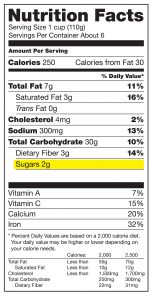Have you ever noticed on ingredient labels that while the recommended daily intake of most nutrients is listed, there is not a daily recommendation for sugar?
While watching Katie Couric’s documentary Fed Up, part of our Wellness Worth Watching Movie Series, I learned why and looked forward to sharing the fascinating information with Desert Health readers.
In 2002, the World Health Organization (WHO), a division of the United Nations responsible for setting global health standards, put together a document known as Technical Report Series 916 (TRS-916) which very specifically indicated that sugar is a major- if not the – cause of chronic metabolic disease and obesity in the world. Based on this information, the WHO proposed a restriction on sugar intake to a level that scientists behind the report recommended stating that no more than 10% of calories in a diet should come from sugar.
It is no surprise that when word reached Washington, D.C., the sugar industry and its lobbyists started their march. This response is certainly not unprecedented for lobbyists in our capital, but the end results are astonishing and continue to have a negative impact on our country today.
As stated in the movie, senators Larry Craig and John Breau, a Republican and a Democrat, asked then secretary of Health and Human Services Tommy Thompson to stop the report. The Bush administration at the time was also resisting a plan from the World Health Organization to fight obesity on an international scale claiming that it was “too tough” on the food industry. Thompson flew to Geneva and “basically told” the World Health Organization that if they published this document, the United States would withhold their $406 million contribution to the WHO.
“In other words, we extorted the WHO to bury this document,” and they succumbed. The sugar recommendation was deleted from most World Health Organization reports going forward, and lobbyists for the sugar industry moved forward with their recommendation that 25% of calories in our daily diet should come from sugar, two and a half times the proposed WHO recommendation.
While food nutrition labels list government recommended daily amounts of various nutrients, today when you look on any food label, you will not find sugar listed with a percentage for the daily recommendation.
It is becoming more and more widely known that sugar is indeed the primary contributor to America’s obesity epidemic, as well as many of the other chronic conditions killing us in alarming numbers. While we know that the food industry is extremely powerful and led by profits, it is disheartening to think that our government has been putting those interests before the health of the American public for generations.
Between 1977 and 2000 Americans have doubled their daily intake of sugar. So let’s go back to 1977. What happened then? Fed Up explains…

Why do labels not include a percentage of daily recommendation for sugar?
If there’s a moment in time marking the start of the obesity epidemic,it’s 1977, the McGovern Report. The Senate Special Committee on Nutrition is looking into the connection between heart disease and diet. Expert testimony before the committee on nutrition and human needs warned Senator George McGovern that obesity would soon be the number one form of malnutrition in the United States…With predictions of rising medical cost, the committee issued the very first dietary goals for Americans noting that our diet had become overly rich in fatty meats, saturated fats and cholesterol, and rich in sugar. The egg, sugar, dairy and beef associations with sales of their products in danger, united, and flat-out rejected the McGovern Report. They even demanded a rewrite.
Despite McGovern’s best intention, the dietary goals were indeed revised and the words “reduced intake” were removed from the report for good. Instead, they encouraged Americans to buy leaner products and buy more food with less fat. And so, the 1980s began with a new health doctrine, and a brand-new market: every food product imaginable reengineered to be low in fat. When you take the fat out of the food, it tastes terrible. Tastes like cardboard. The food industry knew that. So they had to do something to make the food palatable, to make it worth eating. So what did they do? They dumped in the sugar…hiding it behind many names like sucrose, fructose, glucose, dextrose, lactose, maltose, invert sugar, turbinado sugar, and of course, high-fructose corn syrup.
According to a November 2016 report published in the Journal of the American Medical Association (Kearns, Glantz and Schmidt), the sugar industry has been buying their way into our kitchens for over 50 years. Back then, more and more studies were identifying the link between sugar and coronary heart disease, so the sugar industry decided they needed to fund their own research to refute these concerns.
The Sugar Research Foundation (SRF) sponsored research by Harvard scientists that did just that, downplaying the risks of sugar and highlighting the hazards of fat. The result was published in the New England Journal of Medicine in 1967 with no disclosure of the sugar industry funding. Disappointingly, one of the researchers was the chairman of Harvard’s Public Health Nutrition Department and an ad hoc member of the SRF board.
This new report reveals direct influence on research results from the SRF and is raising eyebrows in the world of science. While these actions took place decades ago, it has opened the conversation on today’s practices.
In a follow-up commentary, Marion Nestle, Ph.D., MPH states, “Is it really true that food companies deliberately set out to manipulate research in their favor? Yes, it is, and the practice continues. In 2015, the New York Times obtained emails revealing Coca-Cola’s cozy relationships with sponsored researchers who were conducting studies aimed at minimizing the effects of sugary drinks on obesity. Even more recently, the Associated Press obtained emails showing how a candy trade association funded and influenced studies to show that children who eat sweets have healthier body weights than those who do not.”
So where do we go from here?
As with most things, it is up to each of us to take responsibility for our own health and the health of those in our care, and knowledge is power….
We know that sugar is bad for us and that we should limit its intake. But sugar is addictive – proven in rats to be eight times more addictive than cocaine – so giving it up is not an easy thing. Withdrawals can make us agitated and even ill.
Sugar is poison. It is chronic, not acute, and chronic dose-dependent. The metabolic diseases that are associated with obesity, diabetes, heart disease, lipid problems, strokes, cancer…those diseases are being driven by sugar. How? Fructose, the sweet part of sugar can only be processed in the liver. When your liver is pushed to the max, the pancreas comes to the rescue by producing excess amounts of a hormone called insulin. Insulin is the energy storage hormone. Insulin turns sugar into fat for storage. That’s insulin’s job. High levels of insulin can also block your brain from receiving the signal that you’re full. Problem is your brain thinks you’re starving. So how do you feel when you’re starved? Crappy, tired, slothy. Sit on the couch, don’t want to do anything. And, of course, hungry. Well, I’ve just described every obese patient. The behaviors that we associate with obesity…the eating too much, the exercising too little… the gluttony and the sloth, they are the result of the biochemistry, not the cause.
Cancer’s favorite food and source of energy is sugar. How do doctors identify cancer cells in the human body? They give you a shot of sugar water and watch as the cancer cells outrun their competition to consume the source.
Why do we continue to fuel this insanity? Changing old habits is hard, but giving up sugar is one we should all consider. While the conversation and research continue to grow, it is unlikely that our government will make substantial changes any time soon. However, you can. Just try it for 30 days and see how you feel on day 31. Great resources include JJ Virgin’s Sugar Impact Diet, Dr. William Davis’s Wheat Belly 10-Day Grain Detox, or Diane Sanfilippo’s The 21-Day Sugar Detox.
Each of us can do our part to help protect future generations from the health epidemics we are seeing today. Washing away the candy coating is a good place to start.
Let us know how you are doing and keep the conversation going with comments below.
Editorial by Lauren Del Sarto, Publisher.
Sources: 1) Fed Up: The Movie January 19, 2014. Executive producers Katie Couric, Laurie David and director Stephanie Soechtig.; 2) Cristin E. Kearns, DDS, MBA; Laura A. Schmidt, PhD, MSW, MPH; Stanton A. Glantz, PhD. Sugar Industry and Coronary Heart Disease Research: A Historical Analysis of Internal Industry Documents JAMA Intern Med. 2016;176(11):1680-1685. doi:10.1001/jamainternmed.2016.5394; 3) Marion Nestle, PhD, MPH1, Food Industry Funding of Nutrition Research: The Relevance of History for Current Debates JAMA Intern Med. 2016; 176(11):1685-1686. doi:10.1001/jamainternmed.2016.5400; 4) Camila Domonoski. 50 Years Ago, Sugar Industry Quietly Paid Scientists To Point Blame At Fat. NPR America, September 13, 2016 9:59 AM ET.; 5) Lenoir, Serre, Cantin, Ahmed. Intense Sweetness Surpasses Cocaine Reward PLOS ONE August 1, 2007. http://dx.doi.org/10.1371/journal.pone.0000698; 6) http://www.healthline.com/health-news/tech-sugar-can-be-used-to-detect-cancer-cells-during-mri-scans-070813


















































Comments (0)